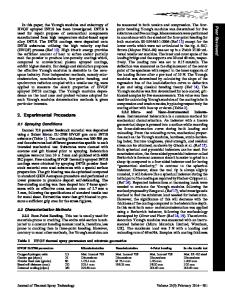INCONEL 718: A solidification diagram
- PDF / 2,099,831 Bytes
- 10 Pages / 597.28 x 785 pts Page_size
- 37 Downloads / 582 Views
I.
INTRODUCTION
I N C O N E L 718 is a Ni-base superalloy having a combination of high strength at moderate temperatures, corrosion and oxidation resistance, and good creep and fatigue resistance. It is one of the most highly utilized Ni-base superalloys, in normal industrial practice, 1NCONEL 718 is welded using filler material, and heat treated after welding. It has an excellent reputation for weldability and resistance to post-weld stress-relief cracking. However, when it is autogenously closure-welded in condi~ tions of high restraint, fusion-zone hot cracking may be encountered. This was the driving force for studying the solidification behavior of I N C O N E L 718. Early work on INCONEL 718 involved understanding the basic physical metallurgy II-sl and weldability I6-91of this alloy system. Recent work on INCONEL 718 relative to the effect of fusion welding I1~ ~3] has involved characterizing microstructures (predominantly in the heat-affected zone) as functions of both alloy chemistry and prior thermal history. In general, two minor microstructural constituents have been identified in weld metals and their associated heat-affected zones: Laves phase and MC-type carbides. Vincent I~~ did an extensive investigation of the heataffected-zone microconstituents in INCONEL 718, employing high resolution electron microscopy techniques. He found Laves phase comprises 80 to 90 vol pct of the minor phases present in the heat-affected zone of INCONEL 718 and that M(Nb or Ti)C-type carbides were also present. Our work complements that of Vincent in that we identify and characterize (phase chemistry) microconstituents in the fusion zone of INCONEL 718 weld metals. During this investigation, enough analytical data were gathered to generate a phase-diagram-like solidification constitution diagram which updates a similar diagram de*INCONEL is a trademark of the INCO family of companies. G . A . KNOROVSKY, M.J. CIESLAK, T.J. HEADLEY, and W. F. HAMMETTER, Members of Technical Staff, and A. D. ROMIG, Jr., Division Supervisor, are with Sandia National Laboratories, Albuquerque, NM 87185. Manuscript submitted May 1, 1987. METALLURGICAL TRANSACTIONS A
veloped over two decades ago E~I using less sophisticated analytical techniques. A true phase diagram presents the loci of stable equilibrium compositions of the various phases present as a function of temperature (and pressure). Thus, since our composition determinations are the result of a nonequilibrium process, i.e., welding, we do not use the term "phase diagram" but have called our diagram a "solidification diagram". Also, we have chosen to represent the data in a simplified pseudo-binary form, using Nb content as the primary alloying element compositional variable. We will justify this choice in the appropriate later section.
II.
EXPERIMENTAL P R O C E D U R E
Four different commercial heats of INCONEL 718 were used in this study. The compositions listed in Table I are the mill analyses, except for the N and O concentrations which were determined by Leco analysis. The m
Data Loading...











